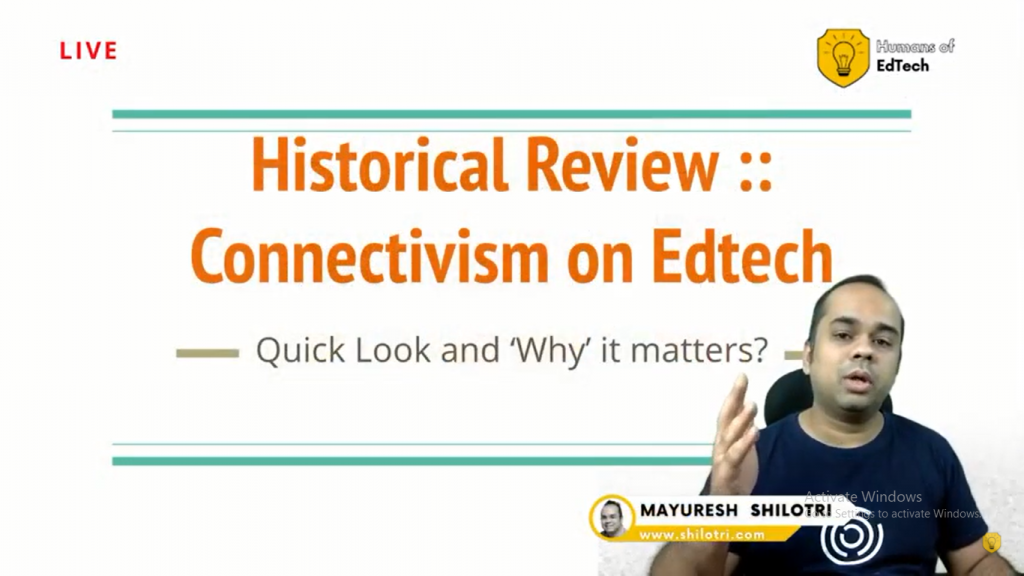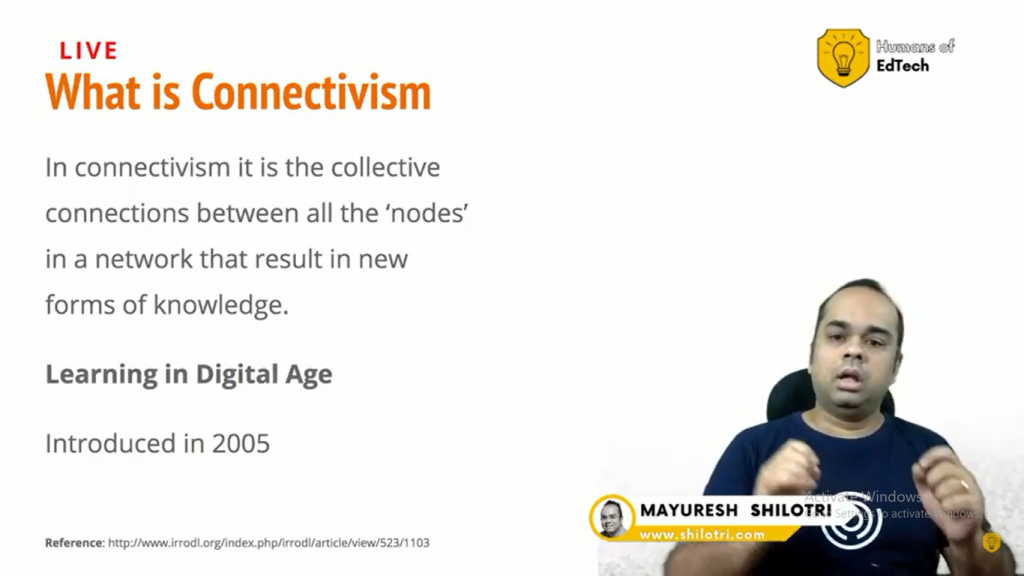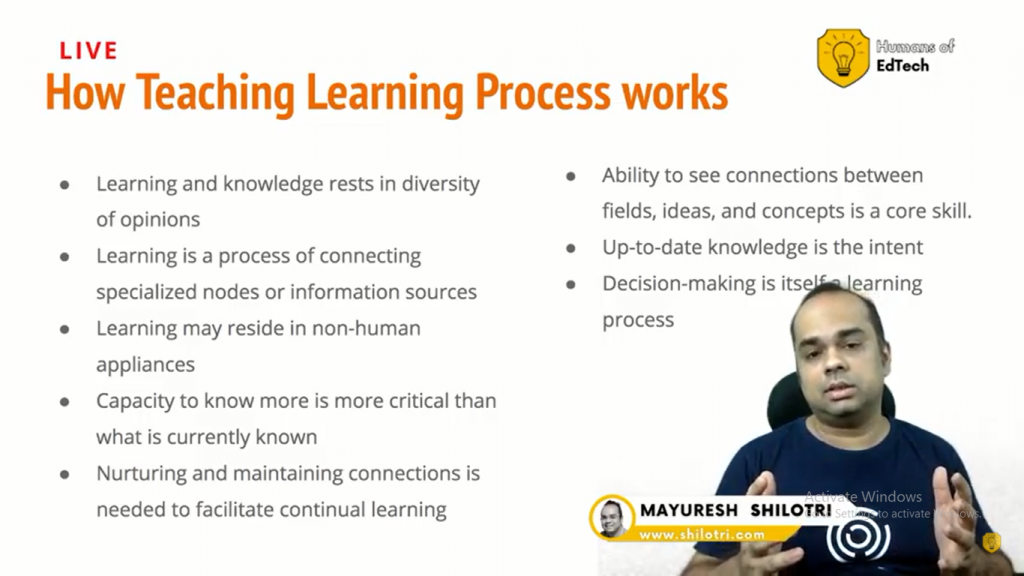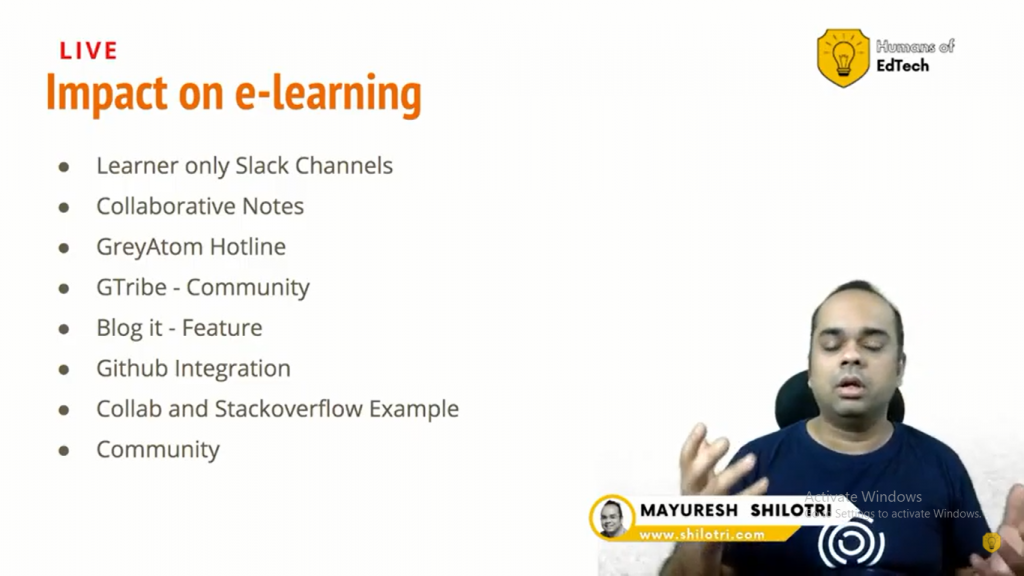Connectivism is the collective connections between all the ‘nodes’ in a network that result in new forms of knowledge. It is the learning of Digital Age, recently introduced in the year 2005.
- WORDS:1287
- TYPE:Post
- VIDEO:1
- SLIDES:1
- TOPIC:Humans Of EdTech
- TIME:8 Minutes
Welcome to another episode of Humans of EdTech, my name is Mayuresh. And once again we are going to have a look at another theory of learning in this particular episode. So let’s quickly jump into this so today we are going to have a look at connectivism.
Now the best thing about this particular theory is that it’s a very recent theory, it was conceptualised as recently as 2005. Some of the other theories, like behaviourism, have existed for more than 100 years. But this is something that is very recent.
So let’s quickly jump into this, we’re gonna have the usual structure with respect to you know, what is connectivism, how the teaching learning happens, and the impact on the adult learning some will share the slide deck with you,
I want to really focus only on one slide, where I want to bring out the examples, I want to explain the examples more than this, because I think the subject matter can very easily be discovered on the web, what essentially cannot be discovered is the real world application of this. So let’s quickly jump into it.

What is connectivism?
So, what is connectivism what it essentially says is that knowledge is there locked parked on different nodes, and these nodes can be human beings, nodes can be machines, nodes can be websites, Wikipedia has anything subject matter experts, knowledge exists over there.
Now, the ability of yours to be able to unlock that, connect all of it and make that knowledge your own either by copying it or either by having it in your reach, that essentially is what is one of the key determinants of success with respect to the ability to garner knowledge, collect knowledge, apply knowledge and everything that is more and more downstream. It is a theory that is more and more applicable to learning in the digital age.
So let’s quickly look at it in what connectivism is, especially some of the applications, some of the principles before that and then we quickly jump into the applications.

How does the teaching learning process work?
So as we spoke about it, it’s about connecting specialised nodes, nodes means people human beings, machines, informations, knowledge essentially rise, because all of these nodes are different, there is diversity over there, it can be non human appliances, also, capacity to know, capture more of these nodes is more critical than what we know at this point in time.
So nurturing and making more connections is absolutely very important to make more and more continuous learning. Let me just, you know, elaborate over here, looking at some phenomena in nature.
And seeing that, okay, there is application by the virtue of biomimicry applicable in a different field is a great ability to see connections between two fields, two disciplines. That’s what essentially means. Something that is up to date, you are absolutely going after something that is latest is very important.
And the decision to make and the ability to make decisions itself is the learning process. Whether you should go after a particular node resource human being captured all of these things to aid in the learning process.

What is its impact on elearning?
Let’s just say that you have a Slack channel that is a learner only Slack channel, where people who are essentially qualified learners, they may be paid learners, people who have opted in to your programmes, and you put together in a Slack channel and suddenly you have like a 1500 people in the Slack channel. So a learner only Slack channel is a very vibrant way where you’re able to access all of these nodes in a very easy way.
So next time when you are in your telegram group, whatsApp groups, it is not just like a group where you’re able to, get a lot of noise, but you’re actually able to unlock all of these nodes as per connectivism.
Collaborative nodes, so these are essentially if you’re able to put together a summary of what you are learning, and then you are able to keep it to yourself or share it with selected people or publish it to the rest of your class or to the whole school.
That’s essentially the collaboration aspect of it and then you also doing the notes taking for yourself. So all of these things, if it can be institutionalised as a feature in one of those products can be really awesome.
GreyAtom hotline is again, one of those things where it opens up to all its students the ability to ask questions asynchronously at any point in time through a recorded video and audio on even a typed out question, and GreyAtom essentially answers them through a video. So that’s the GreyAtom hotline, students can ask them at any point in time.
So students are unlocking the subject matter experts at GreyAtom and they are able to answer them. Any online community, whether it is a meetup community, community, where people are able to access a common wall, post, ask questions, participate.
If you’re capturing something fitting some of these nodes, and if you believe that this is something that is really worthy of sharing in a very structured way, as a blog, can you blog it, can you post it from the same product on the same platform.
Ability to publish your work, your code base, from the GreyAtom learning platform, or any online ID to GitHub, also is a part is a process where you’re accessing essentially adding to the node, you’re being a node, you’re adding a non human node, you’re creating enriching it.
So all of these things are essentially part of what you call as connectivism. Collab and Stackoverflow example, community, I think we spoke about it. So collab, and StackOverflow, essentially, is that collab is an online platform ID, where you’re able to do a lot of Jupiter book style notebooks, and also share it with people.
And it has a very sleek integration with Stackoverflow, where you’re able to query and seek a lot of answers and clarity from Stackoverflow, something very useful, where we are able to marry two nodes for the betterment of the learning process.
So this, in essence, is what connectivism is all about. Let me summarise the definition, essentially, you have nodes, nodes can be people, nodes can be machines, websites, wikis, anything, and your ability to connect all of them, you’re able to traverse a tree really quickly to organise it for your own benefit, helps in your learning process.
And that is what is at the heart of connectivism. It’s a school of learning. That’s more institutionalised very recently as early as 2005. And it absolutely supports everything that you do from a teaching learning perspective at this point in time. I hope this helps.

I hope this serves as a very gentle introduction to what connectivism is. There are a couple of published authors over here. One is Siemens and second is downs.
I think they have their papers very well established and published available freely, please go and check it out. This is just a very simple introduction to it with the applications. I hope this helps follow us and see you around. See you soon. Bye
Photo by fauxels from Pexels.
Join to get sneak peek into what's happening
I write about books, experiences, product, UX, EdTech, early stage growth, validation – mostly tech. Subscribe if these topics interest you. Once every 15 days emailer. I promise – No spam. (I am known for it otherwise) 😉




